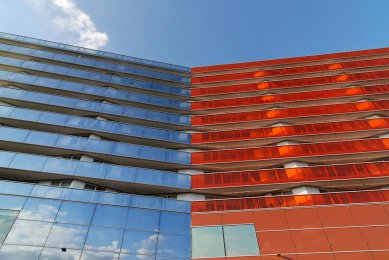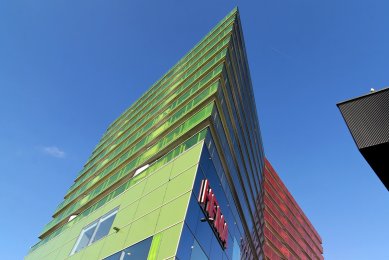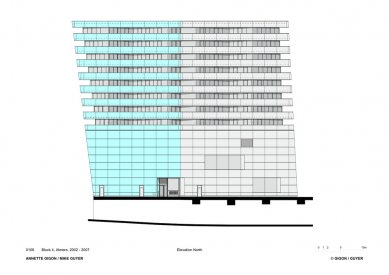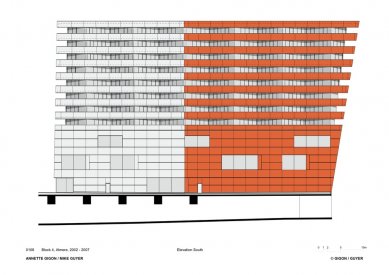
Emerald
Almere residential building

The location is unusual - the Dutch town of Almere is not a place that has grown naturally but rather was planned on a drawing board, originating after the war as polder land reclaimed from the IJsselmeer Lake. The Masterplan for the new town centre was developed by Rem Koolhaas's Office for Metropolitan Architecture. A striking characteristic of this future city centre area is an artificially raised, curved slab (gebogen maaiveld), which connects the existing town centre with the Weerwater Lake as a new pedestrian level. Underneath this plate is an area for the existing east-west connecting local traffic, as well as for deliveries, parking and bus traffic. The planned residential and retail building is situated at the highest point of the curved slab, and it is also the location where the slip road leads down to the 'underworld' of services and infrastructure.
The Masterplan envisions for the residential and retail structure a deep building volume of between 27 and 55 metres. With a trapezoid-shaped floor plan that bends inwards on both sides the maximum possible natural light could be achieved for the residential spaces within the predetermined perimeters. The volume does not grow vertically, but rather inclines towards the south and east and broadens as it ascends.
On the ground and first floors the retail areas are assigned to the department store chain Hema. The second floor forms their storage space. Both basement floors serve as a car park. Originally conceived as freehold apartments, now a total of 72 rented apartments on eight floors will be provided. As a result of the broadening of the building volume towards the top, larger apartments can be provided on the higher, most appealing floors.
On the residential floors the building form is only perceptible on the glazed balcony parapet, while the window frontage of each apartment bends in, thereby forming triangular shaped balcony spaces. The jagged shape of the floor space repeats to a smaller extent the principle of maximising surface area and light, which forms the basis of this large building volume.
The façade is wrapped entirely in glass: colour-enameled glazing is employed for the cladding of the ground floor, the balustrades of the apartment balconies are comprised of safety glass that is laminated with coloured film. The frontage of the residential areas is provided with floor-to-ceiling glazing to maximise light exposure. A colour concept for the building's facades was developed in collaboration with the artist Adrian Schiess: orange for the corners facing the south and east, light green towards the pedestrian area, light blue facing the north and finally highly-reflective silver for half of the two longest, obtuse-angled facades towards the north and south. The inward and outward slanting glazed surfaces reflect the sky and surroundings, while the obtuse-angled surfaces additionally reflect the building itself and the nearby exterior spaces. The immediate surrounding area thus plays an integral part in how the building is perceived.
The Masterplan envisions for the residential and retail structure a deep building volume of between 27 and 55 metres. With a trapezoid-shaped floor plan that bends inwards on both sides the maximum possible natural light could be achieved for the residential spaces within the predetermined perimeters. The volume does not grow vertically, but rather inclines towards the south and east and broadens as it ascends.
On the ground and first floors the retail areas are assigned to the department store chain Hema. The second floor forms their storage space. Both basement floors serve as a car park. Originally conceived as freehold apartments, now a total of 72 rented apartments on eight floors will be provided. As a result of the broadening of the building volume towards the top, larger apartments can be provided on the higher, most appealing floors.
On the residential floors the building form is only perceptible on the glazed balcony parapet, while the window frontage of each apartment bends in, thereby forming triangular shaped balcony spaces. The jagged shape of the floor space repeats to a smaller extent the principle of maximising surface area and light, which forms the basis of this large building volume.
The façade is wrapped entirely in glass: colour-enameled glazing is employed for the cladding of the ground floor, the balustrades of the apartment balconies are comprised of safety glass that is laminated with coloured film. The frontage of the residential areas is provided with floor-to-ceiling glazing to maximise light exposure. A colour concept for the building's facades was developed in collaboration with the artist Adrian Schiess: orange for the corners facing the south and east, light green towards the pedestrian area, light blue facing the north and finally highly-reflective silver for half of the two longest, obtuse-angled facades towards the north and south. The inward and outward slanting glazed surfaces reflect the sky and surroundings, while the obtuse-angled surfaces additionally reflect the building itself and the nearby exterior spaces. The immediate surrounding area thus plays an integral part in how the building is perceived.
Gigon/Guyer Architekten,
08.2007
0 comments
add comment





















